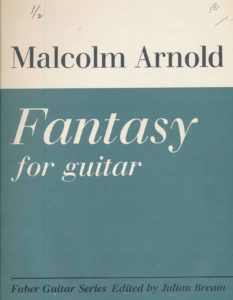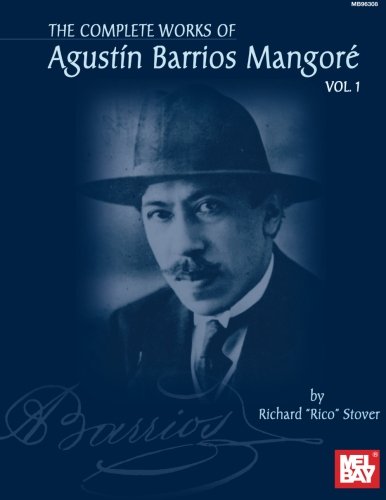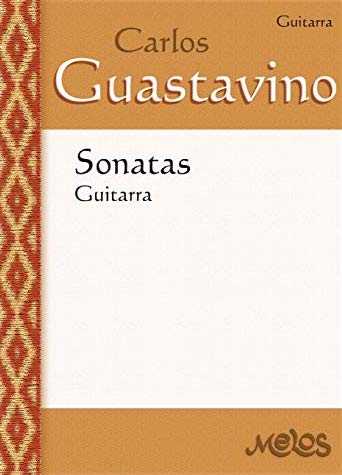
Fantasy for Guitar Op. 107 by English composer Sir Malcolm Arnold (1921-2006) was composed 1971 and consists of seven movements: I. Prelude, II. Scherzo, III. Arietta, IV. Fugetta, V. Arietta, VI. March, VII. Postlude. Edited by Julian Bream in 1971. Arnold’s other guitar works, all written for Bream, include: Serenade for Guitar and Strings, Op. 50 (1955); Guitar Concerto, Op. 67 (1959); Fantasy for Guitar, Op. 107 (1971).
As with many Bream commissions, he worked with reputable composers of the era that were renowned in the greater musical world. Arnold worked in a variety of genres, including a cycle of nine symphonies, concertos, concert works, chamber music, choral, brass and wind bands. The wrote for theatre and was commissioned by Royal Ballet numerous times, and wrote two operas and a musical. He scored more than a hundred films, including The Bridge on the River Kwai (1957) for which he won an Oscar.
Recommended Sheet Music: Fantasy for Guitar, Op.107 by Malcolm Arnold (ed. Bream)
Above YouTube video and this nice write up by Dejan Ivanovic from his Naxos Album:
Malcolm Arnold’s two years of military service during World War II (1944-45) interrupted his early career as a trumpet player with the London and BBC Symphony Orchestras. The experience helped him to write well for all ‘standard’ instruments, as he has done in a wide variety of ‘secular’ musical media. It did not, however, prepare him to compose for the classical guitar but what his intuitive understanding may have lacked was supplied by Julian Bream, who asked him to do so. The first fruit of their collaboration was the Serenade for guitar and strings, Op. 50 (1955), followed by the Guitar Concerto, Op. 67 (1956), two works that have remained in the repertory ever since. Arnold’s music is essentially tonal, melodic in a popular sense, and energetically rhythmic. In the opening and closing movements of the Fantasy one can hear the assertive trumpeter at work. These two and the strong Fughetta frame the contrastingly lyrical and tender Ariettas, and they are linked by a common motif (successive downward steps of a tone and a tone and a half). The repetition in the final movement of other thematic material from the first emphasizes the cyclic nature of the work as a whole.
Shani Inbar plays Fantasy Op.107 by Malcolm Arnold.
You can also check out A survey of the solo guitar works written for Julian Bream by Michael McCallie via The Florida State University, ProQuest Dissertations Publishing, 2015. 10000626. It includes some good sections on Malcolm Arnold works including this excerpt about the Fantasy:
Performer’s Note Malcolm Arnold’s Fantasy, Op. 107 is one of the most tuneful and accessible pieces in the entirety of the Bream repertoire. Unlike the Bennett Sonata or Takemitsu’s All in Twilight, it is tonal and features many compositional devices that sound flattering on the guitar: the prominent use of open strings, three or four-voice textures and open string harmonics. The piece also employs the entire gamut of tactically pleasing extended techniques including rasgueados, tambura, artificial harmonics and the ever-popular technique of crossing the 4th and 5th strings to imitate the sound of a snare drum… The two Ariettas are especially beautiful on the guitar with their singing melodies, sparse texture and harmonies that make use of the open stings.
Of all the Bream pieces, the Arnold Fantasy features more techniques that suit Bream’s playing than any other. As Craig Ogden stated earlier, the two shared a mutual love of jazz and spent a considerable amount of time figuring out how to fit Arnold’s style on the guitar in an idiomatic way, so it only makes since that Bream suggested techniques that he excelled at. The piece includes nearly every favored technique including: chords with high harmonics, tambura and chords that require the player to drag the index finger and thumb across the strings as well as a variety of specified tonal colors…
In the same above dissertation he quotes this Arnold scholar Piers Burton-Page who said the below. It comes from The Art of Julian Bream by Graham Wade.
The Fantasy for guitar, Op. 107 […] [consists of] seven linked sections [that] are […] superbly crafted for the skill of Julian Bream. The first is a Prelude dominated by a three-note ostinato of the interval of a fourth, falling then rising, over which appear a succession of sweeping, majestic chords; the second is a scherzo in six-eight time with chords in groups of three below rapid repeated notes; then comes an Arietta with a typical Arnold three-four melody, marked pp and cantabile; while the fourth section is a brief but energetic Fughetta, interrupted by the fifth, another Arietta whose languor is broken in the middle by five sinister chords ‘tambura,’ […]. The penultimate movement is a March where the guitar cleverly creates a snare-drum effect that highlights the syncopations in the tune above, before the Postlude takes us back to the music of the opening.




